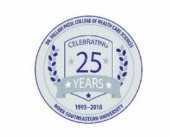NSU Newsroom
SharkBytes
Horizons
This version of NSU News has been archived as of February 28, 2019. To search through archived articles, visit nova.edu/search. To access the new version of NSU News, visit news.nova.edu.
This version of SharkBytes has been archived as of February 28, 2019. To search through archived articles, visit nova.edu/search. To access the new version of SharkBytes, visit sharkbytes.nova.edu.
Through the Looking Glass: An Encapsulated History of the Physical Therapy Department
The Dr. Pallavi Patel College of Health Care Sciences Anniversary Highlights Physical Therapy–Fort Lauderdale
The Physical Therapy Program was one of several programs whose first NSU home was in North Miami Beach, Florida. The late Morton Terry, D.O., M.Sc., FACOI, and The late Arnold Melnick, D.O., M.Sc., FACOP, founders of Southeastern College of Osteopathic Medicine, recognized the opportunity and need to introduce a college of allied health and include a Master of Physical Therapy (M.P.T.) program. This program, which was added to the college after the Physician Assistant Program, was founded and received candidacy in 1994 as a two-year M.P.T. degree program.
After graduation in 1996, the first class anxiously returned to campus for the Commission on Accreditation of Physical Therapy Education (CAPTE) visit. Faculty members and students were elated that the program received a full 10-year accreditation, which was renewed again. During the time of accreditation, the program moved to its new home as part of the Health Professions Division on the NSU Fort Lauderdale/Davie Campus.
The mode of content delivery was rooted in a traditional, classroom-based model. By its second year, it had evolved into a full, problem-based learning program. This continued until 2004, when in response to a national trend and educational needs, the program advanced from an M.P.T. degree to a Doctor of Physical Therapy (D.P.T.) degree. The program was lengthened to three years with both didactic and clinical education modifications. At that time, the decision was made to offer the curriculum in a more traditional format, with integrated cases and alternative approaches.
You may read more about their history in the 2018 Perspectives Summer/Fall issue on page 40 and 42 from the complete article by visiting healthsciences.nova.edu/studentaffairs/messenger.html.
- Catherine Page, Ph.D., PT (1994–1997)
- Cheryl Hill, D.P.T., Ph.D., PT (1997–2003)
- Stanley H. Wilson, Ed.D., PT, CEAS (2003–2011)
- Madeleine Hellman, Ed.D., PT (2011–2016)




